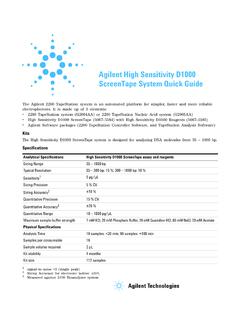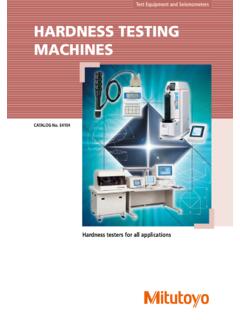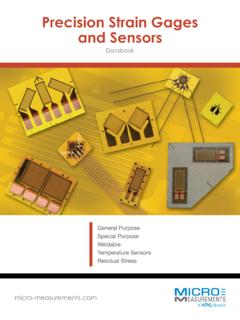Transcription of METHOD 8327 - US EPA
1 SW-846 Update VII 8327- 1 Revision 0 July 2021 METHOD 8327 PER- AND POLYFLUOROALKYL SUBSTANCES (PFAS) BY LIQUID CHROMATOGRAPHY/TANDEM MASS SPECTROMETRY (LC/MS/MS) TABLE OF CONTENTS SCOPE AND 2 SUMMARY OF METHOD .. 5 DEFINITIONS .. 5 INTERFERENCES .. 5 SAFETY .. 7 EQUIPMENT AND SUPPLIES .. 7 REAGENTS AND STANDARDS .. 9 SAMPLE COLLECTION, PRESERVATION, AND STORAGE .. 13 QUALITY CONTROL .. 14 CALIBRATION AND STANDARDIZATION .. 20 PROCEDURE .. 20 DATA ANALYSIS AND CALCULATIONS .. 25 METHOD PERFORMANCE .. 26 POLLUTION PREVENTION .. 26 WASTE 26 REFERENCES .. 27 TABLES, DIAGRAMS, FLOW CHARTS, AND VALIDATION DATA .. 28 TABLE 1. RECOVERY AND precision OF TARGET ANALYTES IN MULTI-LABORATORY STUDY MATRICES PREPARED BY METHOD 3512 .. 29 TABLE 2. RECOMMENDED PRECURSOR IONS AND PRODUCT IONS AND EXAMPLE CHROMATOGRAPHIC RETENTION TIMES.
2 31 TABLE 3. EXAMPLE LIQUID CHROMATOGRAPHY CONDITIONS .. 33 TABLE 4. EXAMPLE MASS SPECTROMETER CONDITIONS .. 34 TABLE 5. EXAMPLE SURROGATE AND TARGET ANALYTE ASSOCIATIONS .. 35 TABLE 6. QC SUMMARY .. 36 FIGURE 1. PFOS PRIMARY AND SECONDARY PRODUCT IONS .. 38 APPENDIX A - GLOSSARY .. 39 SW-846 Update VII 8327- 2 Revision 0 July 2021 Disclaimer SW-846 is not intended to be an analytical training manual. Therefore, METHOD procedures are written based on the assumption that they will be performed by analysts formally trained in the basic principles of chemical analysis and in the use of the subject technology. In addition, SW-846 methods, with the exception of required use for the analysis of METHOD -defined parameters, are intended to be guidance methods which contain general information on how to perform an analytical procedure or technique, which a laboratory can use as a basic starting point for generating its own detailed standard operating procedure (SOP), either for its own general use or for a specific project application.
3 Performance data included in this METHOD are for guidance purposes only and must not be used as absolute quality control (QC) acceptance criteria for the purposes of laboratory QC or accreditation. SCOPE AND APPLICATION This METHOD covers the analysis of selected per- and polyfluoroalkyl substances (PFAS) in prepared samples or sample extracts by liquid chromatography/tandem mass spectrometry (LC/MS/MS). The 24 PFAS that have been evaluated with this METHOD are provided below. This METHOD has been tested in surface water, groundwater, and wastewater matrices. Some precision and bias data are provided in Table 1 (Sec. ). This determinative METHOD may also be applicable to other PFAS target compounds and other matrices, provided that the laboratory can demonstrate adequate performance (refer to Sec. or project-specific acceptance criteria) using representative sample matrices.
4 Please refer to METHOD 8000 for additional information. Analyte Preparation METHOD 3512 CAS RN PFAS sulfonic acids Perfluoro-1-butanesulfonic acid (PFBS) 375-73-5 Perfluoro-1-pentanesulfonic acid (PFPeS) 2706-91-4 Perfluoro-1-hexanesulfonic acid (PFHxS) 355-46-4 Perfluoro-1-heptanesulfonic acid (PFHpS) 375-92-8 Perfluoro-1-octanesulfonic acid (PFOS) 1763-23-1 Perfluoro-1-nonanesulfonic acid (PFNS) 68259-12-1 Perfluoro-1-decanesulfonic acid (PFDS) 335-77-31H, 1H, 2H, 2H-perfluorohexane sulfonic acid (4:2 FTS) 757124-72-4 1H, 1H, 2H, 2H-perfluorooctane sulfonic acid (6:2 FTS) * 27619-97-2 SW-846 Update VII 8327- 3 Revision 0 July 2021 1H, 1H, 2H, 2H-perfluorodecane sulfonic acid (8:2 FTS) 39108-34-4 PFAS carboxylic acids Perfluorobutanoic acid (PFBA) *375-22-4 Perfluoropentanoic acid (PFPeA) *2706-90-3 Perfluorohexanoic acid (PFHxA) 307-24-4 Perfluoroheptanoic acid (PFHpA) 375-85-9 Perfluorooctanoic acid (PFOA) 335-67-1 Perfluorononanoic acid (PFNA) 375-95-1 Perfluorodecanoic acid (PFDA) 335-76-2 Perfluoroundecanoic acid (PFUnDA) *2058-94-8 Perfluorododecanoic acid (PFDoDA) *307-55-1 Perfluorotridecanoic acid (PFTrDA) *72629-94-8 Perfluorotetradecanoic acid (PFTeDA) *376-06-7 PFAS sulfonamides and sulfonamidoacetic acids N- ethylperfluoro-1-octanesulfonamidoacetic acid (N-EtFOSAA) *2991-50-6 N- methylperfluoro-1-octanesulfonamidoaceti c acid (N-MeFOSAA) *2355-31-9 Perfluoro-1-octanesulfonamide (PFOSA)
5 754-91-6 Performance data from a large multi-laboratory validation study were used to update this table (data can be found in Sec. , Table 1). Acceptable precision and bias can be obtained for this analyte with this preparationmethod. * Acceptable precision and bias can be obtained for this analyte with this preparationmethod. However, this analyte may require special care to ensure analytical performance will meet the needs of the project. See Sec. for specific information regarding this analyte. *This analyte did not meet the criteria for acceptable performance using thispreparation technique and determinative METHOD and may require special care to ensure analytical performance will meet the needs of the project. See Sec. for specific information regarding this analyte. Standards for some target analytes may consist of mixtures of structural isomers; however, the Chemical Abstracts Service (CAS) Registry Number (RN) listed in the table is for the linear isomer.
6 All CAS RNs in the above table are for the acid form. Sulfonic acids in stock standard mixes are typically received as the sodium or potassium salt form. CAS RNs for the salt form are not included. SW-846 Update VII 8327- 4 Revision 0 July 2021 Prior to employing this METHOD , analysts are advised to consult the base METHOD for each type of procedure that may be employed in the overall analysis ( , Methods 3500, 3600 and 8000) for additional information on QC procedures, development of QC acceptance criteria, calculations, and general guidance. Analysts also should consult the disclaimer statement at the front of the manual and the information in SW-846 Chapter Two for guidance on the intended flexibility in the choice of methods, apparatus, materials, reagents, and supplies; and (ii ) the responsibilities of the analyst for demonstrating that the techniques employed are appropriate for the analytes of interest, in the matrix of interest, and at the levels of concern.
7 In addition, analysts and data users are advised that, except where explicitly specified in a regulation, the use of SW-846 methods is not mandatory in response to Federal testing requirements. The information contained in this METHOD is provided by the Environmental Protection Agency (EPA) as guidance to be used by the analyst and the regulated community in making judgments necessary to generate results that meet the data quality objectives (DQOs) for the intended application. This METHOD is restricted to use by, or under supervision of, appropriately experienced and trained personnel. Each analyst must demonstrate the ability to generate acceptable results with this METHOD . The following target compounds may require special treatment when being determined by this METHOD : During METHOD development the following compounds showed a potential for loss eit her during standard preparation (resulting in low bias to calibration standards and high recoveries for samples) or during sample preparation (resulting in low recoveries).
8 Extra care should be taken to ensure that the composition of the stock and intermediate standards (those above the high calibration standard) maintain a high enough proportion of organic cosolvent to limit loss from solution (See Sec. ). Sub-sampling from aqueous sample containers prior to adding sufficient organic solvent will also result in a loss of these and potentially other compounds from solution, the extent of which will be container dependent (See Sec. ). Perfluoroundecanoic acid (PFUnDA) Perfluorododecanoic acid (PFDoDA) Perfluorotridecanoic acid (PFTrDA) Perfluorotetradecanoic acid (PFTeDA) N- methylperfluoro-1-octanesulfonamidoaceti c acid (N-MeFOSAA)N- ethylperfluoro-1-octanesulfonamidoacetic acid (N-EtFOSAA) The following compounds lack or have low abundance of secondary product ions, and interferences may make qualitative identification more difficult.
9 Perfluorobutanoic acid (PFBA). Perfluoropentanoic acid (PFPeA) Perfluorohexanoic acid (PFHxA) Perfluoro-1-octanesulfonamide (PFOSA) SW-846 Update VII 8327- 5 Revision 0 July 2021 Background contamination must be carefully evaluated and managed to a level is acceptable for the project-specific data application. During validation of METHOD 3512, some laboratories had problems meeting quality control acceptance criteria for 1H, 1H, 2H, 2H-perfluorooctane sulfonic acid (6:2 FTS) due to high and/or sporadic background contamination. More information about identifying and minimizing sources of contamination is presented in Sec. SUMMARY OF METHOD Samples are prepared using an appropriate sample preparation METHOD ( , solvent dilution or extraction). Prepared samples or extracts are then analyzed by LC/MS/MS using external standard calibration. Target compounds are qualitatively identified in samples by comparing retention times (RTs) to RTs of isotopically labeled surrogates in the same samples or to RTs of target analytes in standards, as applicable, and by comparing product ion ratios to those in standards (Sec.)
10 , Sec. Table 2) . Qualitatively identified target compounds are then quantitated based on their primary product ion responses utilizing external standard calibration (Sec. ). DEFINITIONS Refer to SW-846 Chapter One and the manufacturer's instructions for definitions that may be relevant to this procedure. See Glossary (Appendix A) for relevant terms and acronyms. INTERFERENCES In order to avoid compromising data quality, contamination of the analytical system by PFAS from the laboratory must be reduced to the lowest practical level. METHOD blanks (MBs) and reagent blanks (RBs) are prepared and analyzed with all samples and are used to demonstrate that laboratory supplies and preparation and analysis steps do not introduce interferences or PFAS artifacts at levels that would prevent the proper identification and integration of target analytes or bias quantitation, especially near the Lower Limit of Quantitation (LLOQ) or any project-specific concentration levels of interest.













